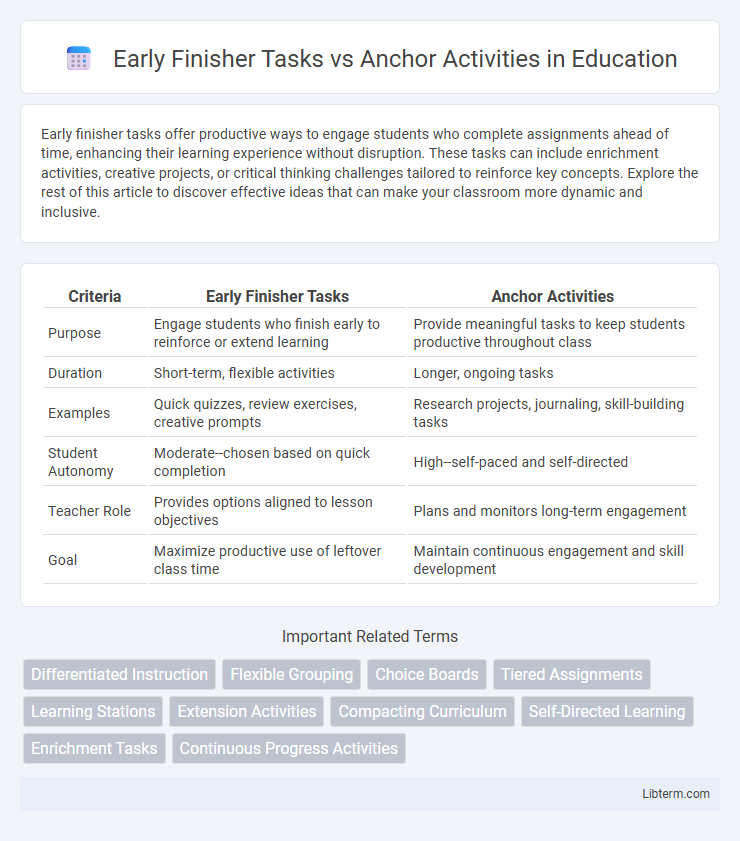Early finisher tasks offer productive ways to engage students who complete assignments ahead of time, enhancing their learning experience without disruption. These tasks can include enrichment activities, creative projects, or critical thinking challenges tailored to reinforce key concepts. Explore the rest of this article to discover effective ideas that can make your classroom more dynamic and inclusive.
Table of Comparison
| Criteria | Early Finisher Tasks | Anchor Activities |
|---|---|---|
| Purpose | Engage students who finish early to reinforce or extend learning | Provide meaningful tasks to keep students productive throughout class |
| Duration | Short-term, flexible activities | Longer, ongoing tasks |
| Examples | Quick quizzes, review exercises, creative prompts | Research projects, journaling, skill-building tasks |
| Student Autonomy | Moderate--chosen based on quick completion | High--self-paced and self-directed |
| Teacher Role | Provides options aligned to lesson objectives | Plans and monitors long-term engagement |
| Goal | Maximize productive use of leftover class time | Maintain continuous engagement and skill development |
Understanding Early Finisher Tasks
Early Finisher Tasks are designed to engage students who complete their assigned work ahead of time, promoting continuous learning and minimizing downtime. These tasks often include enrichment activities, extension problems, or creative projects tailored to enhance critical thinking skills and reinforce key concepts. Unlike Anchor Activities, which serve as ongoing work for all students, Early Finisher Tasks specifically target accelerated learners to maintain classroom productivity and motivation.
What Are Anchor Activities?
Anchor activities are purposeful tasks assigned to students who complete their primary work early, designed to keep them engaged without disrupting the classroom flow. These activities often include enrichment exercises, independent reading, or skill reinforcement, promoting continuous learning while allowing teachers to support other students. Implementing effective anchor activities helps maximize instructional time and fosters self-directed learning habits.
Key Differences Between Early Finisher Tasks and Anchor Activities
Early Finisher Tasks are short, optional assignments designed for students who complete their work ahead of time, allowing them to stay engaged without disrupting classroom flow. Anchor Activities are more structured, ongoing tasks intended to keep students productive for an extended period, often reinforcing core skills or concepts independently. The key difference lies in duration and purpose: Early Finisher Tasks offer brief enrichment or review, while Anchor Activities provide sustained, meaningful engagement that supports differentiated learning.
Benefits of Early Finisher Tasks
Early finisher tasks enhance student engagement by providing meaningful activities that extend learning beyond the primary lesson, preventing downtime and off-task behavior. These tasks support differentiated instruction by catering to diverse learning paces and styles, promoting autonomy and fostering critical thinking skills. Incorporating early finisher tasks in the classroom improves time management and encourages continuous intellectual growth, benefiting both fast learners and the overall learning environment.
Advantages of Anchor Activities in the Classroom
Anchor activities enhance classroom management by providing meaningful, independent tasks that engage early finishers without constant teacher intervention. These activities promote student autonomy and sustained focus, supporting differentiated learning by allowing students to explore subjects at their own pace. Implementing well-designed anchor activities reduces downtime and behavioral issues, creating a productive and inclusive learning environment.
Challenges with Early Finisher Tasks
Early finisher tasks often struggle with engagement and relevance, leading to boredom and off-task behavior among students. These tasks may lack differentiation, failing to meet the diverse learning needs and abilities in the classroom. Managing classroom flow becomes challenging when early finishers require constant redirection or additional support.
Potential Drawbacks of Anchor Activities
Anchor activities can lead to student disengagement due to their repetitive and non-challenging nature, particularly for early finishers who require more stimulating tasks. These activities risk promoting off-task behavior, as students may become bored or frustrated when forced to complete redundant work. Furthermore, anchor activities often do not cater to diverse learning needs, limiting opportunities for personalized growth and deeper understanding.
Best Practices for Implementing Early Finisher Tasks
Early finisher tasks should be purposeful, differentiated, and aligned with learning objectives to keep students engaged without disrupting classroom flow. Integrating varied activities such as enrichment projects, problem-solving challenges, and reflection prompts allows learners to deepen understanding and develop critical skills independently. Clear expectations, flexible timing, and seamless transitions between primary tasks and early finisher activities enhance effectiveness and promote a positive, productive classroom environment.
Tips for Integrating Anchor Activities Effectively
Implement anchor activities that align with key curriculum objectives and can be independently managed by students to maximize engagement and learning retention. Design tasks with varying difficulty levels and multiple entry points to ensure accessibility and challenge for all learners. Utilize formative assessments during anchor activities to monitor progress and provide timely feedback, fostering continuous improvement and accountability.
Choosing the Right Approach: Early Finisher Tasks vs. Anchor Activities
Choosing the right approach between early finisher tasks and anchor activities depends on aligning with specific classroom goals and student needs. Early finisher tasks offer targeted, skill-reinforcing exercises that prevent downtime without overwhelming students ready to move ahead. Anchor activities provide open-ended, meaningful engagement that fosters deeper exploration and independent learning for students who complete primary tasks early.
Early Finisher Tasks Infographic

 libterm.com
libterm.com